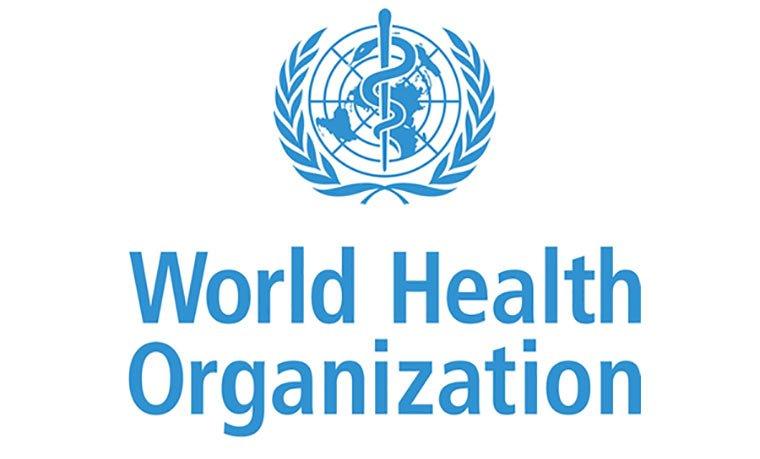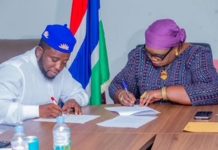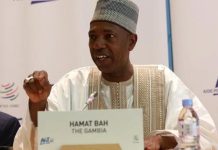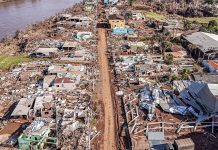Africa-Press – Gambia. World Health Organisation has advised countries to adhere strictly to the COVID safety protocols such as use of face masks, social distancing and hand-washing to limit transmission of the BA.2; one of the three sublineages of Omicron. two others are BA.1 and BA. 3.
WHO on November 26, 2021, designated the variant B.1.1.529 a variant of concern named Omicron. Speaking with Sunday PUNCH on Saturday, the WHO Regional Virologist, Dr Nicksy Gumede-Moeletsi, noted that among the three sub-lineages of Omicron, the features found in the B.A 2 seemed to be highly transmissible.
sub-lineage is reportedly responsible for an increase in infections across the world but Omicron is a general name for many several directly related lineages of the SARS-CoV-2 COVID. Countries especially in Asia and Europe were reported to have recorded an increase in cases linked to BA.2.
Gumede-Moeletsi stated, “All countries are at risk as long as BA.2 is circulating due to population movement. We emphasise the COVID regulations of masks, social distance and handwashing to limit spread. Read Also Africa yet to overcome Omicron-fuelled fourth wave, says WHOAnalyst outlines Omicron impact on oil demand‘Nigerians attributing cough, catarrh to AA genotype may have contracted Omicron’
“ message is that countries yet to comply with the COVID regulations should do so. This is because this is the only way to stop transmission and spread of infection. BA. 2 is highly transmissible compared to the other two; B.A 1 and B.A 3. But when it comes to disease severity, all of them seem to be the same like other Omicrons.’’
In Africa, the WHO noted that the BA.1 sub-lineage were recorded in countries such as Algeria, Angola, Botswana, Comoros, Democratic Republic of the Congo, Egypt, Eswatini, Gambia, Ghana, Kenya, Malawi, , Mali, Mauritius, Morocco, Mozambique, Namibia, Nigeria, Republic of Congo, Rwanda, Senegal, South Africa, Tunisia, Uganda, Zambia and Zimbabwe. For BA. 2 (Stealth), the international health agency stated that cases were reported in Botswana, Kenya, Malawi, Mauritius, Mozambique, Senegal and South Africa, while Botswana, Egypt, Mozambique, Namibia and South Africa recorded cases of BA.3.
Copyright PUNCH.All rights reserved. This material, and other digital content on this website, may not be reproduced, published, broadcast, rewritten or redistributed in whole or in part without prior express written permission from PUNCH. Contact: [email protected]
The WHO on November 26, 2021, designated the variant B.1.1.529 a variant of concern named Omicron. Speaking with Sunday PUNCH on Saturday, the WHO Regional Virologist, Dr Nicksy Gumede-Moeletsi, noted that among the three sub-lineages of Omicron, the features found in the B.A 2 seemed to be highly transmissible.
The sub-lineage is reportedly responsible for an increase in infections across the world but Omicron is a general name for many several directly related lineages of the SARS-CoV-2 COVID. Countries especially in Asia and Europe were reported to have recorded an increase in cases linked to BA.2.
Gumede-Moeletsi stated, “All countries are at risk as long as BA.2 is circulating due to population movement. We emphasise the COVID regulations of masks, social distance and handwashing to limit spread. Read Also Africa yet to overcome Omicron-fuelled fourth wave, says WHOAnalyst outlines Omicron impact on oil demand‘Nigerians attributing cough, catarrh to AA genotype may have contracted Omicron’
“The message is that countries yet to comply with the COVID regulations should do so. This is because this is the only way to stop transmission and spread of infection. The BA. 2 is highly transmissible compared to the other two; B.A 1 and B.A 3. But when it comes to disease severity, all of them seem to be the same like other Omicrons.’’
In Africa, the WHO noted that the BA.1 sub-lineage were recorded in countries such as Algeria, Angola, Botswana, Comoros, Democratic Republic of the Congo, Egypt, Eswatini, Gambia, Ghana, Kenya, Malawi, , Mali, Mauritius, Morocco, Mozambique, Namibia, Nigeria, Republic of Congo, Rwanda, Senegal, South Africa, Tunisia, Uganda, Zambia and Zimbabwe. For BA. 2 (Stealth), the international health agency stated that cases were reported in Botswana, Kenya, Malawi, Mauritius, Mozambique, Senegal and South Africa, while Botswana, Egypt, Mozambique, Namibia and South Africa recorded cases of BA.3.
Copyright PUNCH.All rights reserved. This material, and other digital content on this website, may not be reproduced, published, broadcast, rewritten or redistributed in whole or in part without prior express written permission from PUNCH. Contact: [email protected]
Speaking with Sunday PUNCH on Saturday, the WHO Regional Virologist, Dr Nicksy Gumede-Moeletsi, noted that among the three sub-lineages of Omicron, the features found in the B.A 2 seemed to be highly transmissible.
The sub-lineage is reportedly responsible for an increase in infections across the world but Omicron is a general name for many several directly related lineages of the SARS-CoV-2 COVID. Countries especially in Asia and Europe were reported to have recorded an increase in cases linked to BA.2.
Gumede-Moeletsi stated, “All countries are at risk as long as BA.2 is circulating due to population movement. We emphasise the COVID regulations of masks, social distance and handwashing to limit spread. Read Also Africa yet to overcome Omicron-fuelled fourth wave, says WHOAnalyst outlines Omicron impact on oil demand‘Nigerians attributing cough, catarrh to AA genotype may have contracted Omicron’
“The message is that countries yet to comply with the COVID regulations should do so. This is because this is the only way to stop transmission and spread of infection. The BA. 2 is highly transmissible compared to the other two; B.A 1 and B.A 3. But when it comes to disease severity, all of them seem to be the same like other Omicrons.’’
In Africa, the WHO noted that the BA.1 sub-lineage were recorded in countries such as Algeria, Angola, Botswana, Comoros, Democratic Republic of the Congo, Egypt, Eswatini, Gambia, Ghana, Kenya, Malawi, , Mali, Mauritius, Morocco, Mozambique, Namibia, Nigeria, Republic of Congo, Rwanda, Senegal, South Africa, Tunisia, Uganda, Zambia and Zimbabwe. For BA. 2 (Stealth), the international health agency stated that cases were reported in Botswana, Kenya, Malawi, Mauritius, Mozambique, Senegal and South Africa, while Botswana, Egypt, Mozambique, Namibia and South Africa recorded cases of BA.3.
Copyright PUNCH.All rights reserved. This material, and other digital content on this website, may not be reproduced, published, broadcast, rewritten or redistributed in whole or in part without prior express written permission from PUNCH. Contact: [email protected]
The sub-lineage is reportedly responsible for an increase in infections across the world but Omicron is a general name for many several directly related lineages of the SARS-CoV-2 COVID. Countries especially in Asia and Europe were reported to have recorded an increase in cases linked to BA.2.
Gumede-Moeletsi stated, “All countries are at risk as long as BA.2 is circulating due to population movement. We emphasise the COVID regulations of masks, social distance and handwashing to limit spread. Read Also Africa yet to overcome Omicron-fuelled fourth wave, says WHOAnalyst outlines Omicron impact on oil demand‘Nigerians attributing cough, catarrh to AA genotype may have contracted Omicron’
“The message is that countries yet to comply with the COVID regulations should do so. This is because this is the only way to stop transmission and spread of infection. The BA. 2 is highly transmissible compared to the other two; B.A 1 and B.A 3. But when it comes to disease severity, all of them seem to be the same like other Omicrons.’’
In Africa, the WHO noted that the BA.1 sub-lineage were recorded in countries such as Algeria, Angola, Botswana, Comoros, Democratic Republic of the Congo, Egypt, Eswatini, Gambia, Ghana, Kenya, Malawi, , Mali, Mauritius, Morocco, Mozambique, Namibia, Nigeria, Republic of Congo, Rwanda, Senegal, South Africa, Tunisia, Uganda, Zambia and Zimbabwe. For BA. 2 (Stealth), the international health agency stated that cases were reported in Botswana, Kenya, Malawi, Mauritius, Mozambique, Senegal and South Africa, while Botswana, Egypt, Mozambique, Namibia and South Africa recorded cases of BA.3.
Copyright PUNCH.All rights reserved. This material, and other digital content on this website, may not be reproduced, published, broadcast, rewritten or redistributed in whole or in part without prior express written permission from PUNCH. Contact: [email protected] Countries especially in Asia and Europe were reported to have recorded an increase in cases linked to BA.2.
Gumede-Moeletsi stated, “All countries are at risk as long as BA.2 is circulating due to population movement. We emphasise the COVID regulations of masks, social distance and handwashing to limit spread. Read Also Africa yet to overcome Omicron-fuelled fourth wave, says WHOAnalyst outlines Omicron impact on oil demand‘Nigerians attributing cough, catarrh to AA genotype may have contracted Omicron’
“The message is that countries yet to comply with the COVID regulations should do so. This is because this is the only way to stop transmission and spread of infection. The BA. 2 is highly transmissible compared to the other two; B.A 1 and B.A 3. But when it comes to disease severity, all of them seem to be the same like other Omicrons.’’
In Africa, the WHO noted that the BA.1 sub-lineage were recorded in countries such as Algeria, Angola, Botswana, Comoros, Democratic Republic of the Congo, Egypt, Eswatini, Gambia, Ghana, Kenya, Malawi, , Mali, Mauritius, Morocco, Mozambique, Namibia, Nigeria, Republic of Congo, Rwanda, Senegal, South Africa, Tunisia, Uganda, Zambia and Zimbabwe. For BA. 2 (Stealth), the international health agency stated that cases were reported in Botswana, Kenya, Malawi, Mauritius, Mozambique, Senegal and South Africa, while Botswana, Egypt, Mozambique, Namibia and South Africa recorded cases of BA.3.
Copyright PUNCH.All rights reserved. This material, and other digital content on this website, may not be reproduced, published, broadcast, rewritten or redistributed in whole or in part without prior express written permission from PUNCH. Contact: [email protected]
Gumede-Moeletsi stated, “All countries are at risk as long as BA.2 is circulating due to population movement. We emphasise the COVID regulations of masks, social distance and handwashing to limit spread. Read Also Africa yet to overcome Omicron-fuelled fourth wave, says WHOAnalyst outlines Omicron impact on oil demand‘Nigerians attributing cough, catarrh to AA genotype may have contracted Omicron’
“The message is that countries yet to comply with the COVID regulations should do so. This is because this is the only way to stop transmission and spread of infection. The BA. 2 is highly transmissible compared to the other two; B.A 1 and B.A 3. But when it comes to disease severity, all of them seem to be the same like other Omicrons.’’
In Africa, the WHO noted that the BA.1 sub-lineage were recorded in countries such as Algeria, Angola, Botswana, Comoros, Democratic Republic of the Congo, Egypt, Eswatini, Gambia, Ghana, Kenya, Malawi, , Mali, Mauritius, Morocco, Mozambique, Namibia, Nigeria, Republic of Congo, Rwanda, Senegal, South Africa, Tunisia, Uganda, Zambia and Zimbabwe. For BA. 2 (Stealth), the international health agency stated that cases were reported in Botswana, Kenya, Malawi, Mauritius, Mozambique, Senegal and South Africa, while Botswana, Egypt, Mozambique, Namibia and South Africa recorded cases of BA.3.
Copyright PUNCH.All rights reserved. This material, and other digital content on this website, may not be reproduced, published, broadcast, rewritten or redistributed in whole or in part without prior express written permission from PUNCH. Contact: [email protected]
“The message is that countries yet to comply with the COVID regulations should do so. This is because this is the only way to stop transmission and spread of infection. The BA. 2 is highly transmissible compared to the other two; B.A 1 and B.A 3. But when it comes to disease severity, all of them seem to be the same like other Omicrons.’’
In Africa, the WHO noted that the BA.1 sub-lineage were recorded in countries such as Algeria, Angola, Botswana, Comoros, Democratic Republic of the Congo, Egypt, Eswatini, Gambia, Ghana, Kenya, Malawi, , Mali, Mauritius, Morocco, Mozambique, Namibia, Nigeria, Republic of Congo, Rwanda, Senegal, South Africa, Tunisia, Uganda, Zambia and Zimbabwe. For BA. 2 (Stealth), the international health agency stated that cases were reported in Botswana, Kenya, Malawi, Mauritius, Mozambique, Senegal and South Africa, while Botswana, Egypt, Mozambique, Namibia and South Africa recorded cases of BA.3.
Copyright PUNCH.All rights reserved. This material, and other digital content on this website, may not be reproduced, published, broadcast, rewritten or redistributed in whole or in part without prior express written permission from PUNCH. Contact: [email protected]
In Africa, the WHO noted that the BA.1 sub-lineage were recorded in countries such as Algeria, Angola, Botswana, Comoros, Democratic Republic of the Congo, Egypt, Eswatini, Gambia, Ghana, Kenya, Malawi, , Mali, Mauritius, Morocco, Mozambique, Namibia, Nigeria, Republic of Congo, Rwanda, Senegal, South Africa, Tunisia, Uganda, Zambia and Zimbabwe. For BA. 2 (Stealth), the international health agency stated that cases were reported in Botswana, Kenya, Malawi, Mauritius, Mozambique, Senegal and South Africa, while Botswana, Egypt, Mozambique, Namibia and South Africa recorded cases of BA.3.
Copyright PUNCH.All rights reserved. This material, and other digital content on this website, may not be reproduced, published, broadcast, rewritten or redistributed in whole or in part without prior express written permission from PUNCH. Contact: [email protected]
For More News And Analysis About Gambia Follow Africa-Press






